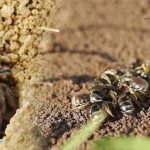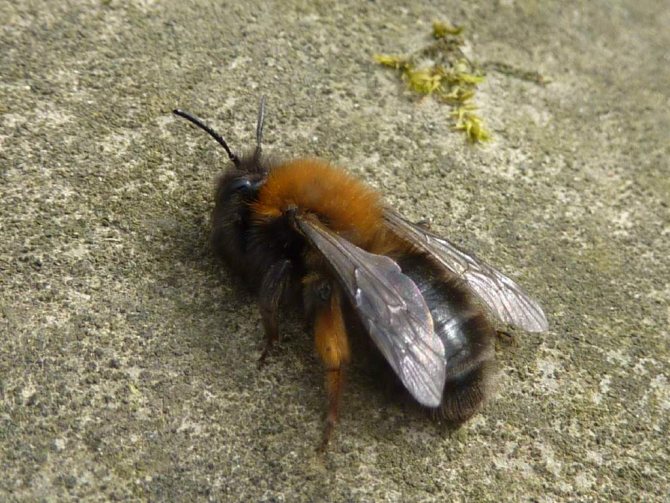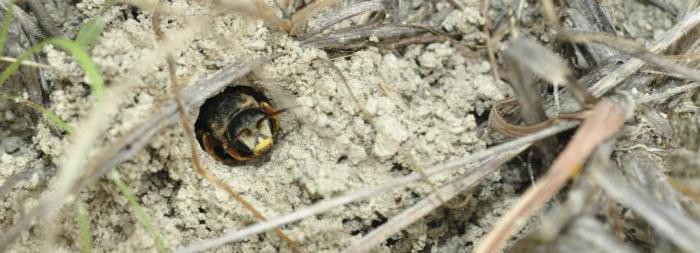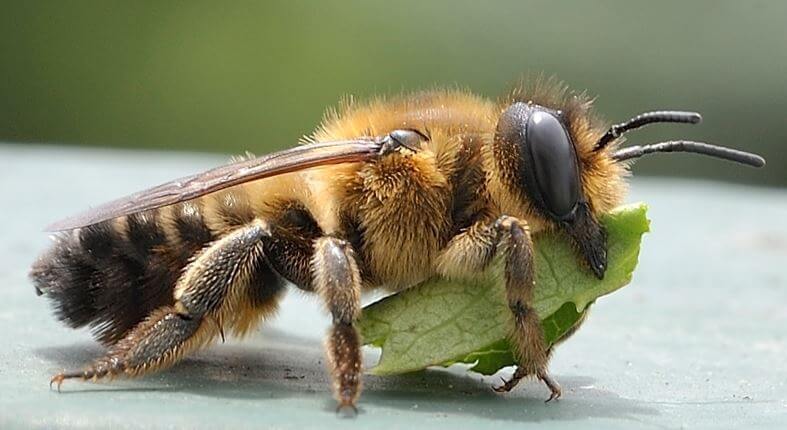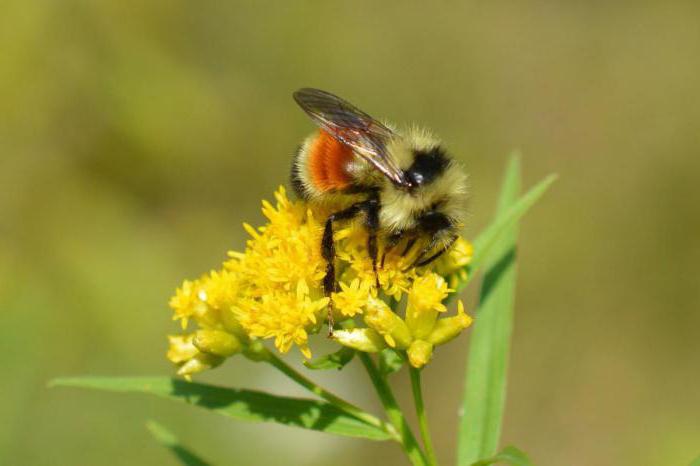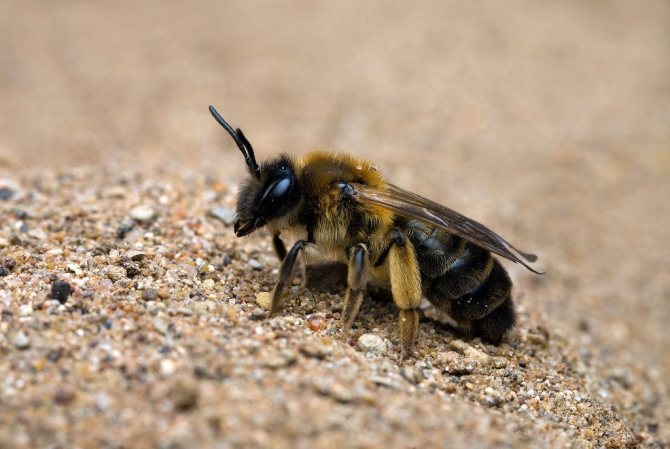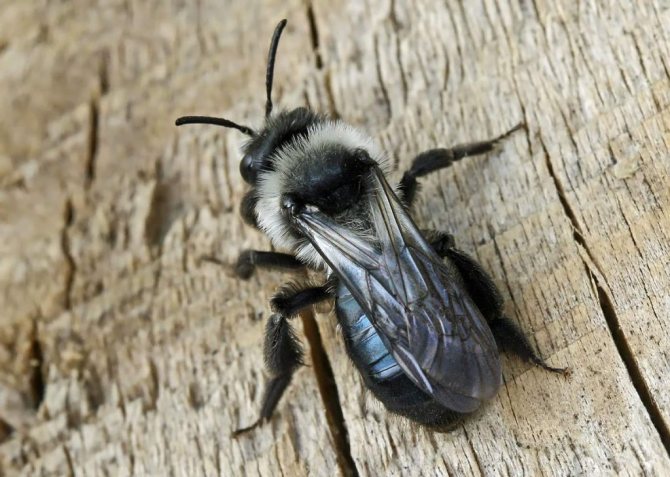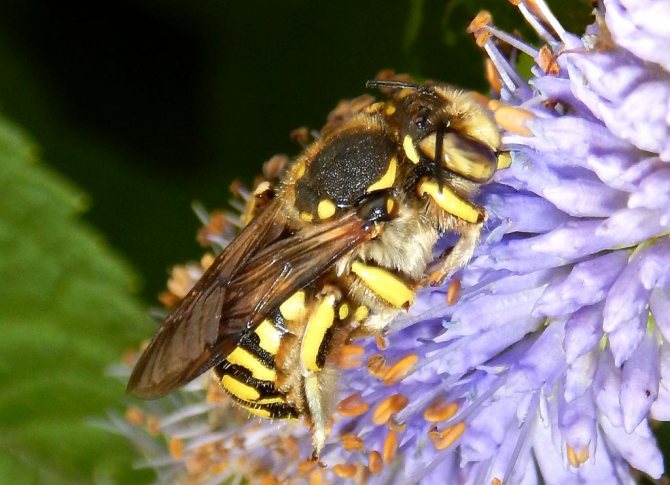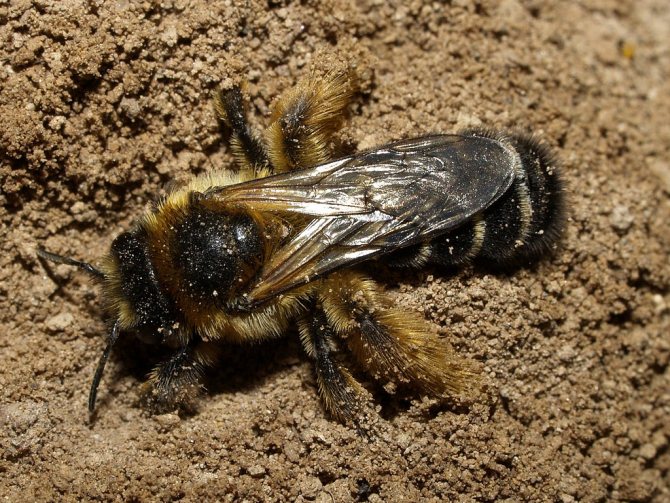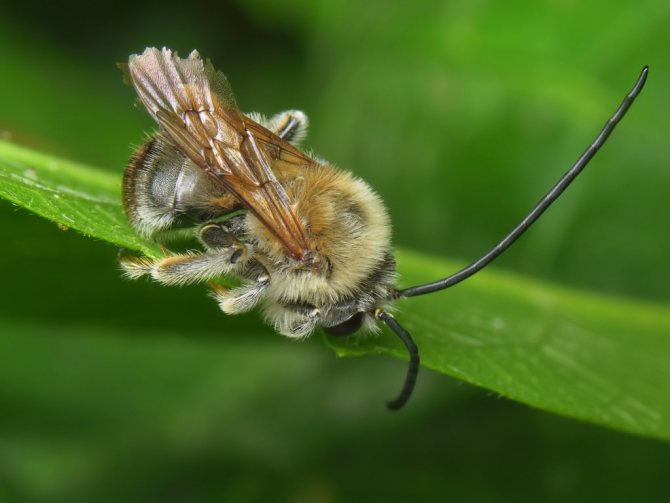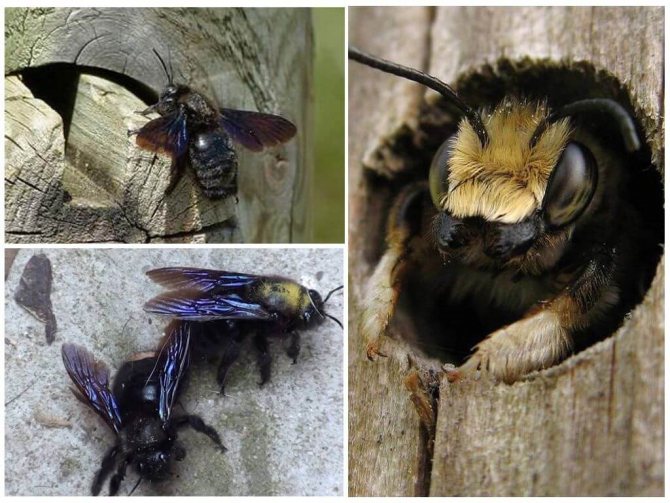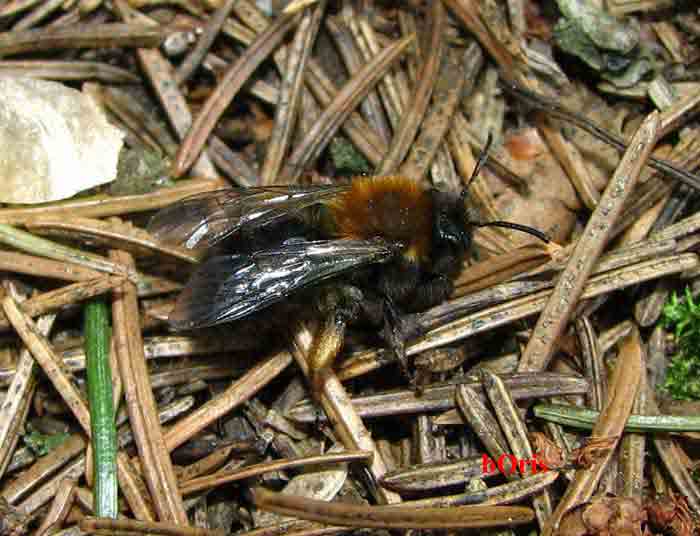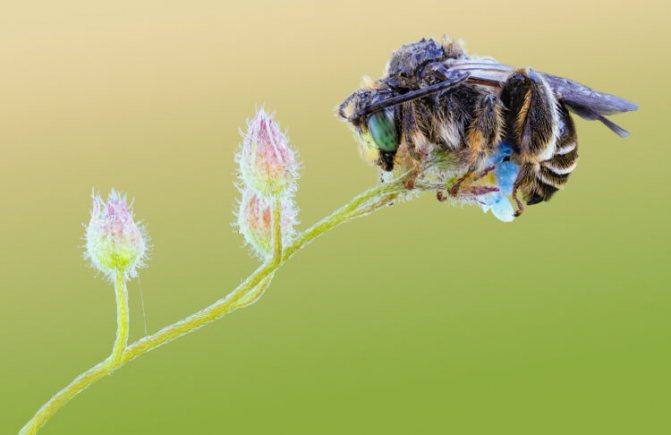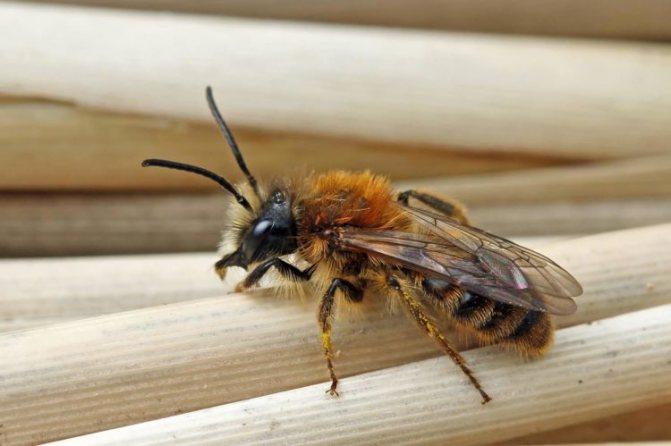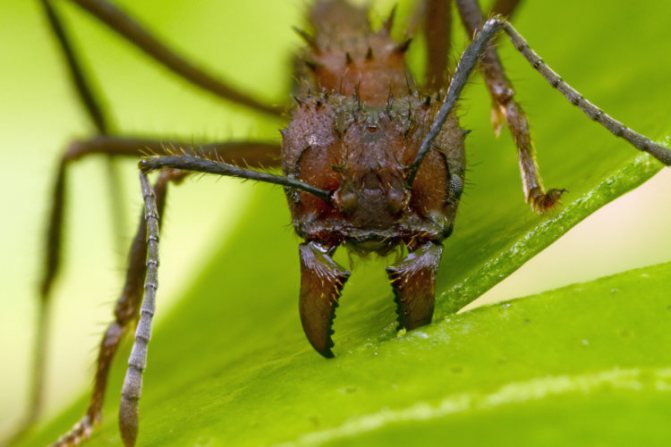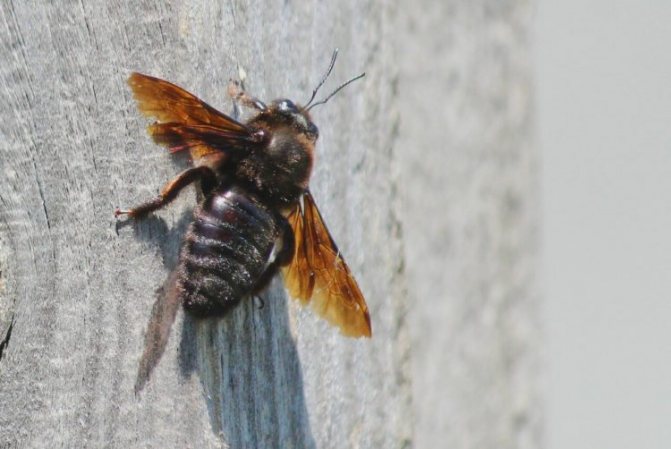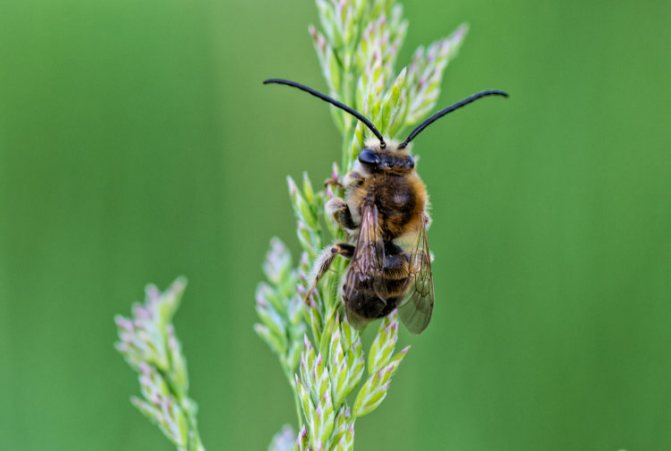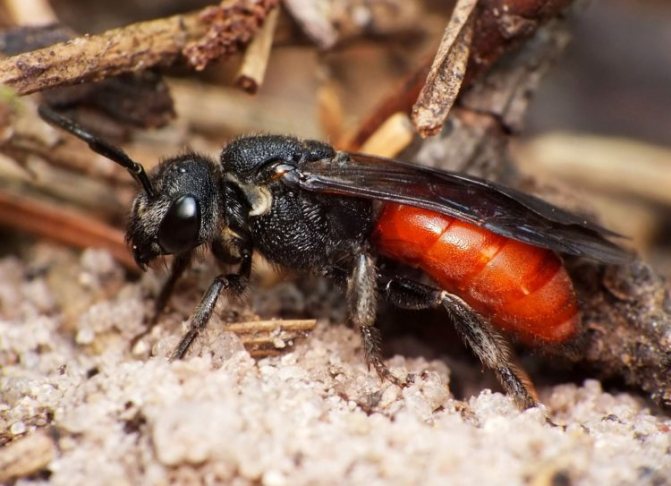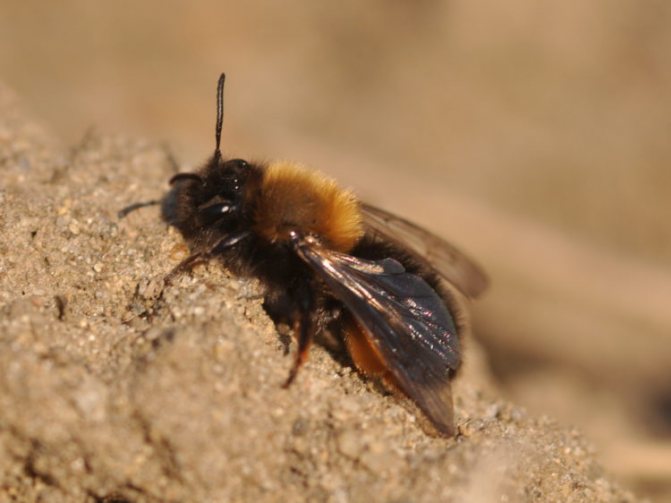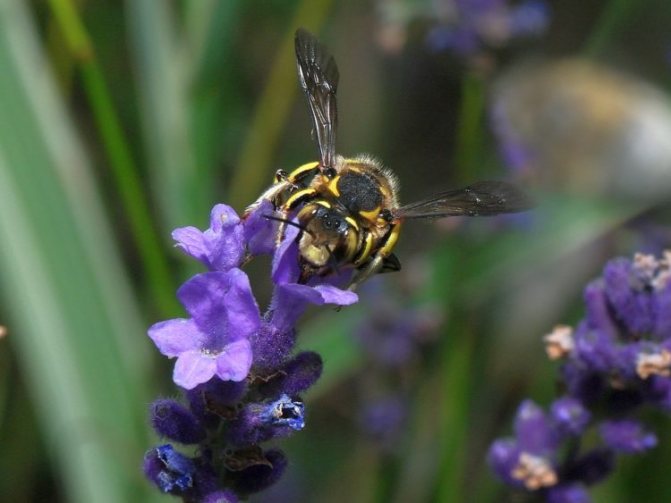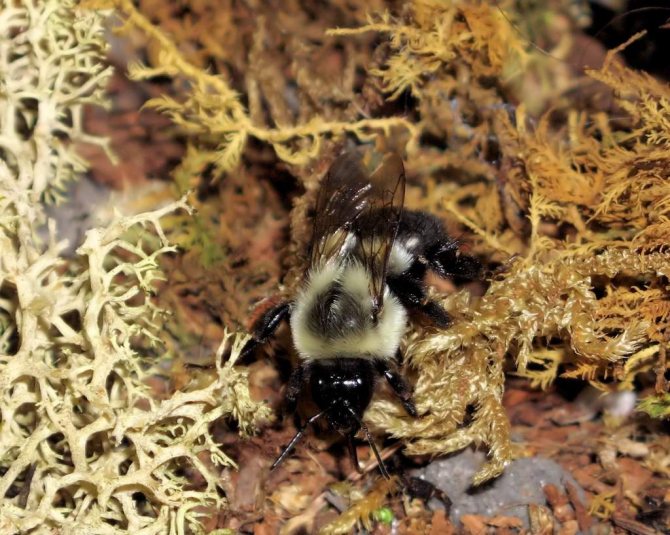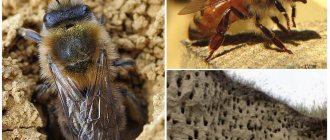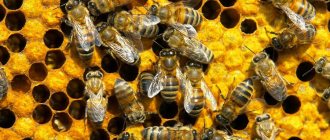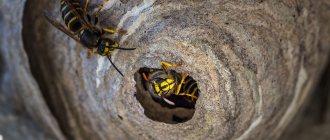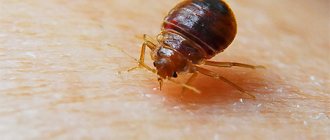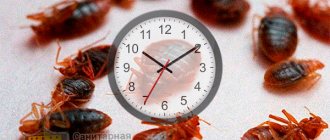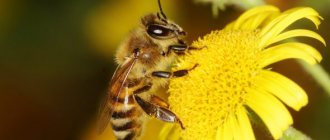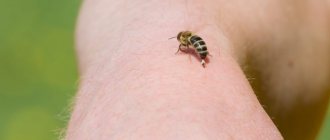Earth bees, insects that live in the soil, equip nests in dug tunnels. Solitary individuals are often found in clearings and forest edges. Bee colonies sometimes settle in summer cottages, which is a danger to humans. Bites often lead to side effects and unpleasant consequences. Therefore, it is better to get rid of these "neighbors" in a timely manner.
Appearance and features
Earth bees have distinctive characteristics: black body color, black-brown head color and dark purple wings. The size of bees can be up to 19 mm. Males have almost no differences from females, but their body size reaches a maximum of 15 mm. Bees have light vellus hairs on the abdomen, and yellow spots on the upper lip and jaw.
Earthen bees have thick dark gray or light gray hairs on the chest and head. The temples and head are covered with black pubescent hairs. These insects love to dig holes in sandy areas, forests, fields.
Where do they live and how they live
Insects are distributed practically in all regions of the earth, with the exception of:
- South America;
- Oceania;
- Madagascar;
- Australia.
There are more than 400 species of earth bees on the European continent alone.
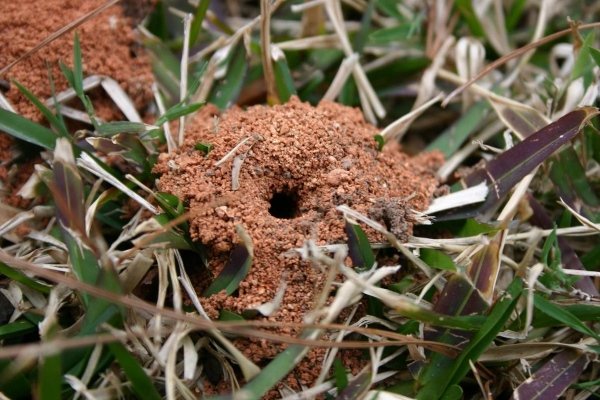
Most of them prefer to nest in sandy or loose sandy loam soil, breaking through peculiar tunnels up to 80 cm deep. That is why small nests can be found in flower beds or front gardens. However, these insects can equip their homes in other places:
- in the cavities of the rocks;
- in the inter-brick space of the walls, especially often they can be found in old buildings;
- in the stems of some plants.
What types are there?
Few people know that earth bees are not uncommon, just less common. The size of the insect population, in comparison with domestic bees, is small. In addition, people have ceased to be in nature often, which is why this type of bee went unnoticed by human eyes.
There are some varieties of ground bees - they differ in color, size, body structure and other features.
Andrena-Clarkella
A common insect known all over the world. Body sizes can reach from 8 to 17 mm. The color of the bee is different, there are black and blue, sometimes orange specimens. There is fluff on the head and upper back.
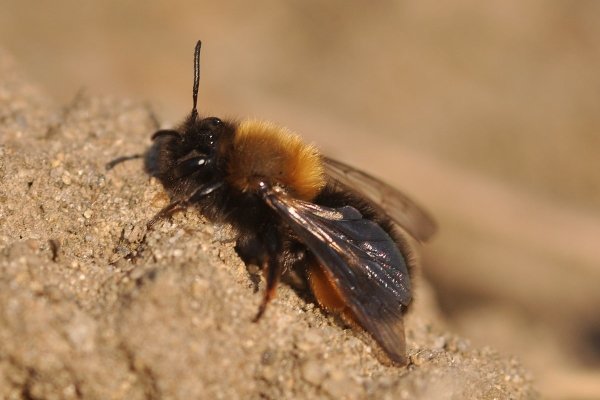

Andrena Magna
A less popular variety found exclusively on the Black Sea coast. The bee is dominated by a black body, purple wings, and a yellow upper back. The body length reaches 15-18 mm. There are thick fluffy hairs on the head and upper body.
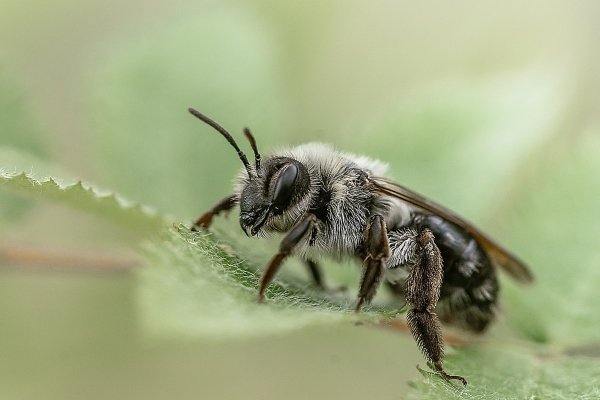

Halict sphecodes
It is a medium-small earth bee, ranging in size from 5 to 15 mm. Something like a wasp. A distinctive characteristic is the body color - reddish, sometimes greenish with a metallic sheen. Insects are common all over the world.
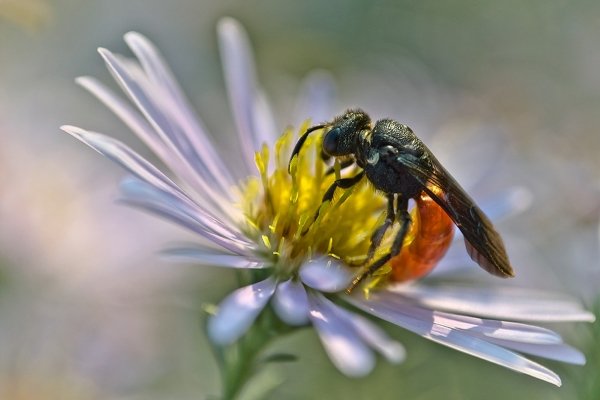

Long-wattled bee
This species of wild bees can be found from Europe to Kazakhstan. Insects have a grayish-red body color, thick and long antennae, a small body size. An interesting fact is that two females are able to get along in one nest.
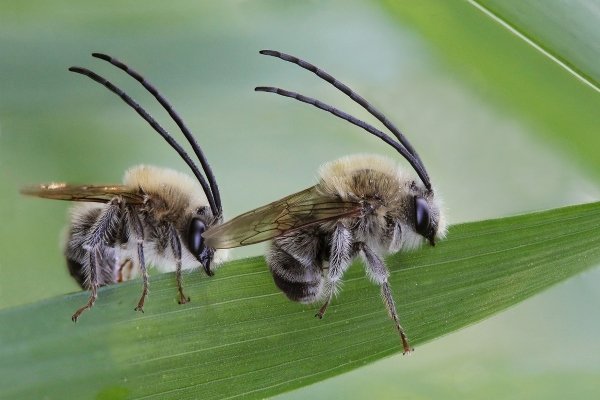

Wool bits
The peculiarity of this variety is considered to be a kind of "theft".The wool beats themselves do not dig holes, but they successfully use other people's dwellings, line cells from plant fibers. A characteristic feature is the small size of the insect, brown color with yellow spots on the back. Insects are slightly plump. In relation to other insects, males are very aggressive.
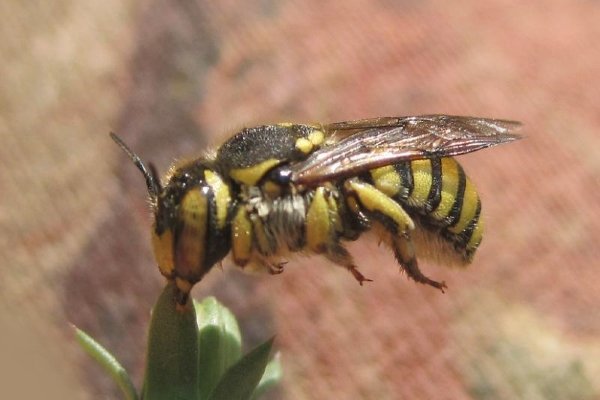

Sheet cutters (megaheels)
Leaf cutters are solitary bees. They have strong jaws, but insects do not produce honey. Decorate dwellings using pieces of plant leaves.
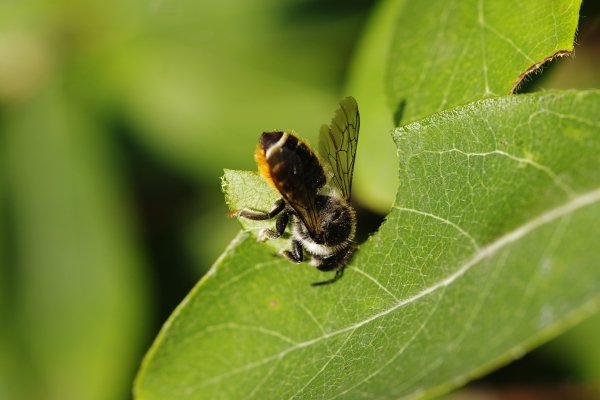

Nomada (cuckoo)
The nomad bee is outwardly similar to the domesticated relative, but the earth bee does not have an apparatus for collecting pollen. There are no hairs on the surface of the body. These bees do not build their nests. They got the name "cuckoo bee" by laying their eggs in other people's holes, where later larvae grow and feed on the reserves of the nomads.
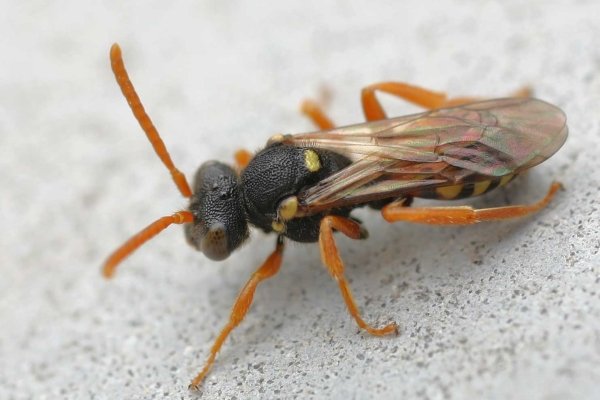

Mellithids
Outwardly, this variety is similar to the domestic honey bee. Their peculiarity is the way of eating. Melitids collect nectar exclusively from flowers of legumes or Asteraceae plants.
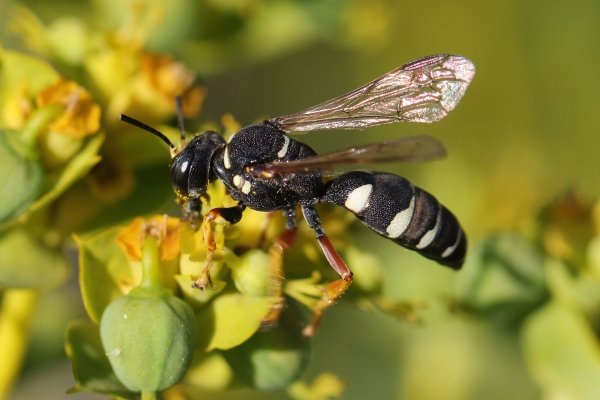

A carpenter
A bee characterized by a loud buzzing. The carpenter bee is large in size, the eyes are dark blue or black, the wings and body are blue with a purple tint. The carpenter is a lone bee.
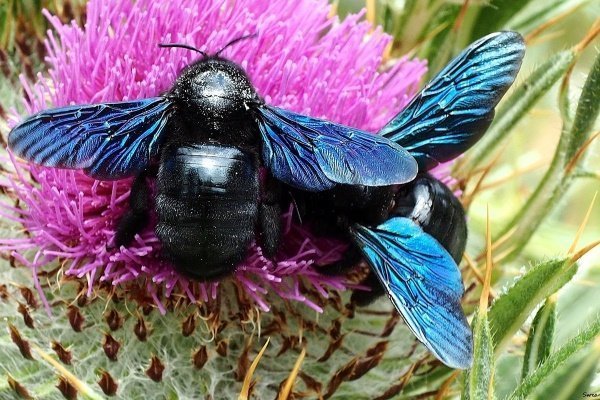

Difference from domestic honey insects
Although underground bees extract honey in the same way as their domesticated relatives, there are many differences between them:
- Lodging... Earth bees do not live in hives, trees or hollows. They only build their homes underground. Mostly in the sand.
- Color... Unlike normal bees, earthen bees are rather dark in color, which makes them almost invisible in the soil.
- Family arrangement... Underground melliferous plants do not have such a differentiated hierarchy as their domestic counterparts.
What kind of life do they lead?
Earth bees can live both singly and in whole groups. Depends on the variety. Basically, insects settle in whole colonies, sometimes several families can live in one hole at the same time. When the offspring grows up, it does not move far from the parental home, but settles nearby, digging out tunnels, thereby expanding the bee kingdom.
There are also such insects, which are preferable to live not in groups, but individually, for example, this is characteristic of bees-carpenters and bees-leaf cutters. The female lives in the nest alone with her larvae until all the offspring is ripe.
Interesting Facts
It is interesting:
- Not all earth bees produce honey.
- In winter, insects do not fall asleep. Throughout this period, they feed on honey reserves.
- The English monarch Richard loaded bees into special pipes and released them from a cannon at opponents.
- Egyptians are considered the first beekeepers in the world.
- Having lost its sting when bitten, the bee soon dies.
- The most poisonous species live in Africa.
Earth bees are little-known wild insects that live almost everywhere. By themselves, they are not dangerous. And some species are included in the Red Book.
Without destroying their nests, a person not only will not get a bite, but will also preserve an endangered species, which is important for the entire ecosystem as a whole.
What are the beneficial properties of honey?
Earthen wild bees have aromatic honey dominated by a hazy aroma with a tart taste at the same time. Honey predominates with a thick consistency, has a rich brown color, contains a huge amount of bee bread and wax.
It is believed that regular consumption of honey from earth bees helps to cope with the following problems:
- cosmetic mistakes;
- ARI;
- inflammatory processes;
- sore throat;
- muscle pain;
- bronchitis;
- joint diseases;
- pneumonia.
The range of applications for this product is wide. Due to its amazing beneficial properties, the consumption of honey guarantees the strengthening of the immune system. Honey from wild earth bees matures slowly and retains its medicinal properties for a long time.
The period when honey is collected in the forest is short, only a few weeks in autumn. During this time, insects manage to procure a sufficient amount of honey. Today, it is popular to collect honey from bees, for which special hives are installed in the forest, where the bee colony makes nests. Collect honey from the beads carefully so as not to accidentally destroy the nest. The extracted honeycomb is opened manually, thus preserving the valuable properties of the product. The collection of honey is carried out only with wooden objects. Store honey in wooden or earthenware dishes.
Practical instructions for getting rid of earth bees
Of course, professionals should do everything. Therefore, it is better to entrust getting rid of bees to fighters with such bees. But, if you have not found any, you will have to take on the mission of freeing your garden plot. And, before you start military operations, you need to thoroughly prepare for such a war.
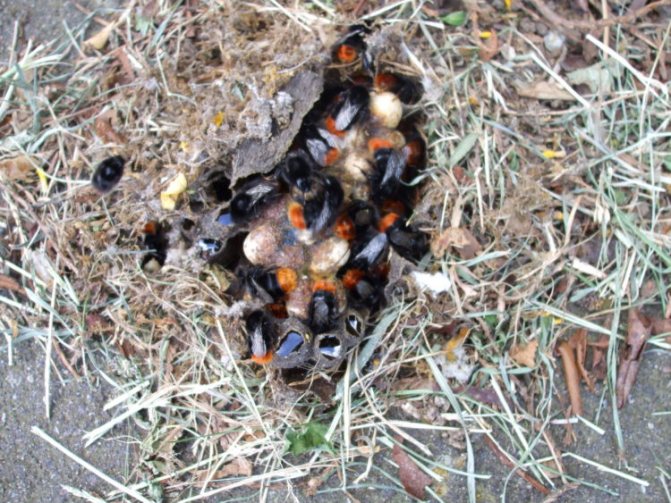

- Start with a first aid kit. Your first aid kit must have an antidote for bee stings. This is especially true for those who do not know if they are allergic to bee stings or not. If you do have an allergy, this antidote can even save your life.
- It is only necessary to start hostilities when children and animals have been evacuated. They can get under the "hot wing" from angry bees, so let your household, including four-legged ones, cheer for you at home.
- The best time to fight earth bees is at the end of winter. Why, exactly then? Everything is very simple. During this period, the colony of earth bees is still not so numerous, and the bees themselves do not behave so aggressively and mobile. At any other time of the year, it is several times more difficult to fight such neighbors and conquerors of your dacha, if only because there are more bees and they behave more confidently and aggressively. As for the time of day, it is certainly evening.
- Trying to just cover a hive of earth bees with earth or sand is actually a useless and rather dangerous exercise. If the bees manage to find a way out into the light, then you and your loved ones will definitely not be good at it. Furious insects will sting everyone
Arrangement of the "home"
The holes that insects tear out are somewhat similar to deep tunnels. Numerous oval-shaped dead-end depressions extend from them in different directions. In some of these cavities, bees store honey. The advantage is that in such a chamber the nectar is stored as in a container, without losing its taste and healing qualities. This is due to the fact that earth bees tend to equip their homes in a certain way. This work is painstaking for them.
First of all, insects dig out an oval tunnel, then a cell is created in it, and the liberated earth is mixed with saliva. Bees put such a mixture in a circle, tamping them with their paws, after which they treat the entire surface obtained with a special substance - the secret of the abdominal glands. After the surface hardens, the home is reliably protected from moisture and other weather conditions.
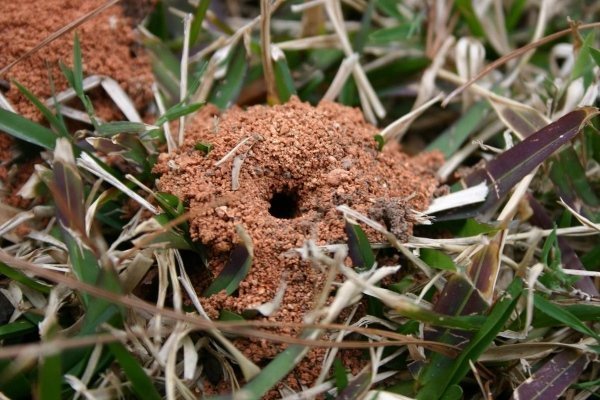

How do they look
Most species of wild bees are very similar to the honeybees we often see in apiaries. However, there is such a variety of these insects on the planet that it is simply impossible to make any definite description of their appearance. Of all the existing species of bees on earth, 80% are just earth bees.
Despite such a variety, you can distinguish a bee from an apiary from an earthen one by the following features:
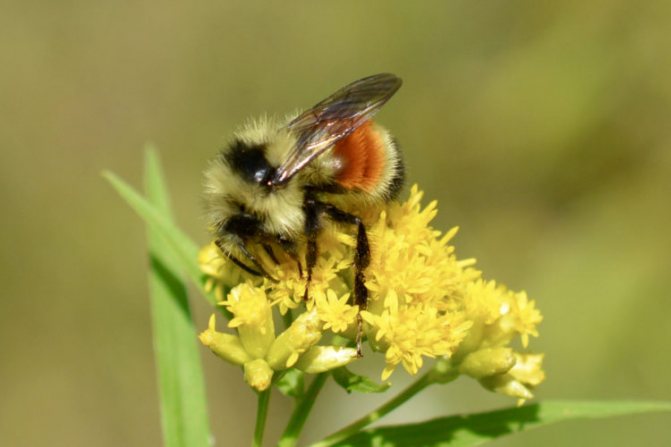

- on average, the length of the body is from 8 to 17 mm (males and females, in size, differ little);
- the wings are slightly curved, the basal vein is almost straight;
- color can be varied: black, blue, green, silver, etc.;
- females have a swivel tassel on their hind legs.
The body of insects, as a rule, has a thick coat of hair on the head and chest area.
Offspring
Only after the arrangement of the underground house, the uterus will go to the most remote place of the nest, where she will lay eggs in wax cells. Periodically, before laying eggs, some species of ground bees put plant fibers or finely cut pieces of leaves into cells.
As the larvae grow, the female gradually begins to increase the size of the cells where the offspring live. After the offspring grows up, the uterus dies. This happens with almost all species of ground bees. But only the female "Galikt sphecodes" is able to survive even in the most severe frosts. And young individuals, actively growing and developing, begin to do the same thing as other relatives: harvest honey and nectar.
Do bees live in the ground
Underground bees, like bees familiar to us, group around their queen, which founds a colony, finding a burrow abandoned by some rodent. First of all, she has to prepare the mink for laying the larvae. For this it is necessary: Bees living in the ground do not create large colonies. They gravitate towards chamber life. The underground passages that they dig do not exceed 80 cm in length, but this is a whole branched network of semicircular tunnels, always ending in dead-end "cells", where larvae are deposited and honeycombs are built from wax, which are filled with honey.
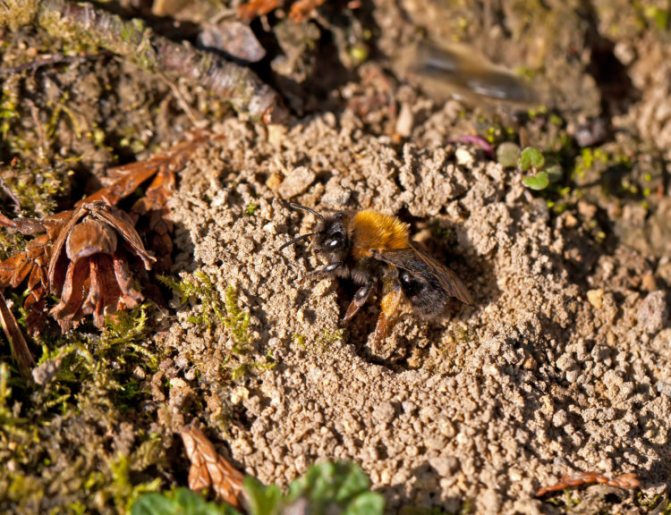

- Build a mink out of loose earth moistened with your own saliva.
- Line the bottom of the mink with plant leaves.
- Lay out the first clutch of eggs.
- To get food for the larvae ourselves, until the young grow up, then the next clutch of larvae will be raised together.
- Put nectar in special chambers to feed the offspring.
Benefit and harm
Thanks to the vital activity of such bees, many flowering plants are pollinated. Agricultural lands benefit from earth bees.
But earth bees can also cause harm, for example, pulling unsightly holes in the ground in large quantities. Today, when most of the roads are paved or poisoned by poisonous fumes, earth bees seek refuge in villages and dachas. If there is a vegetable garden on the site, bees will interfere with planting work, and if there is a garden, they will simply disfigure it. It would seem that they benefit from this, for example, it is not difficult to get honey from holes. But this is not the case. After all, you will have to destroy the nest, and the danger for an inexperienced person is great, bees can bite.
Bites are another problem. A bee sting is not very pleasant anyway, and the sting of earth bees is dangerous, because it can cause an aggravated allergic reaction.
Why are earth bees dangerous?
Wild andrens are beneficial for the economy and the ecosystem as a whole, as they provide high yields through pollination of crops. Insects also provide healing honey, rich in vitamins and minerals. However, they often settle near people - in the country, in a flower bed, in the wall of a house. Although the Andrens are peaceful, they attack when they sense danger.
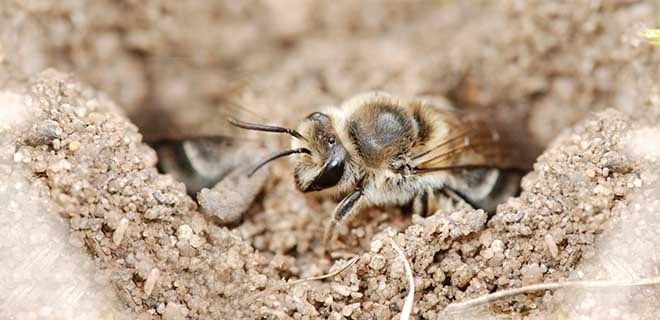

A sting from an earthen bee is dangerous for people with an allergic reaction to the poison. Manifestations: soreness, redness and slight fever. Toxic substances after a bite quickly enter the bloodstream or mucous membranes. Sometimes this leads to severe muscle spasms, swelling of the larynx, if not assisted, it can be fatal.
What to do with a bite?
The insect venom contains a large amount of histamine, which can lead to an allergic reaction, manifested by inflammation of the tissues at the site of the bite and swelling. Be sure to immediately remove the sting - this helps to reduce the possible consequences.In order to get the sting, use tweezers. If the sting does not protrude above the surface, the surrounding skin is slightly pressed down.
Alcohol or sweetened water will help neutralize the poison. The wound is treated with a liquid, a piece of ice is applied on top, previously wrapped in gauze. Due to the fact that an earthen bee sting can cause a strong allergic reaction, it is advisable to take an antihistamine or lubricate the bite with a special ointment.
During the day, be sure to drink plenty of fluids, exclude alcoholic beverages, because they can increase the effect of toxins contained in the venom of the earth bee. If a severe reaction develops, go to the hospital right away to avoid serious complications.
Description
As wild creatures, they live in fields, forest plantations and in areas in quiet areas, where the soil contains a large amount of sand. They are grouped by families with a large number, subsequently the offspring are placed next to the former house, which is why vast areas of settlements are formed underground.
The tunnels in the dwellings are very durable and go to great depths, since the earth bee is an excellent builder. Insects are quite peaceful and do not attack for no apparent reason. It should be noted that these individuals, like any others, may be more aggressive at different times.
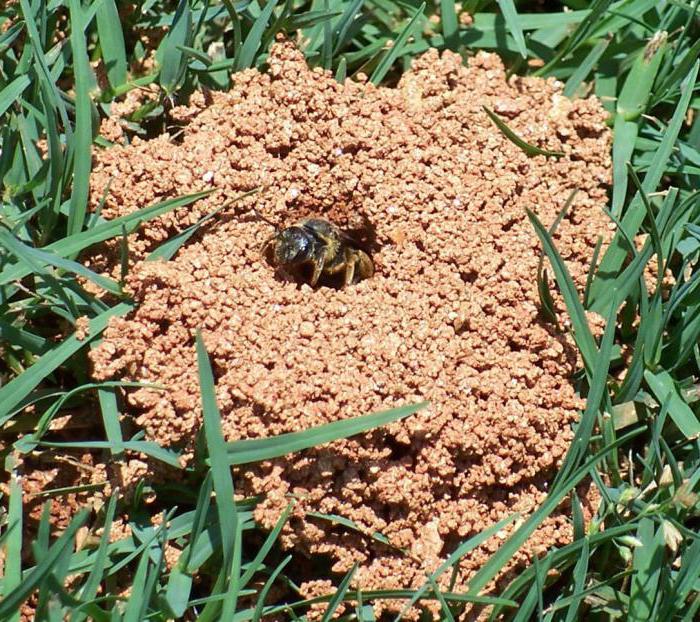

Fighting the buzzers
Unfortunately, no owner will like the fact that earth bees live on his site. This fact can be explained by the behavior of insects. Bees that live underground are distinguished by their aggressive nature. If a working bee stings a person, then only in case of real danger, but an earthen inhabitant is capable of attacking her victim for no reason.
The insect brings no less harm to the surrounding plants - it gnaws at the foliage. And the construction of labyrinths underground will not bring huge benefits to young seedlings. It is because of such negative moments that the desire to get rid of pests wakes up in every gardener. There are many ways to deal with earth bees.
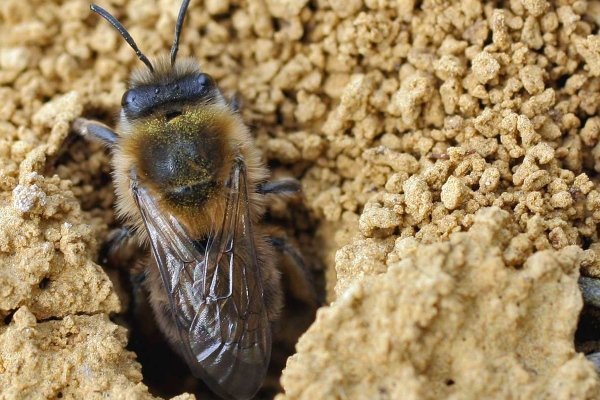

Boiling water will help the cause
It is more popular and simple to deal with earth inhabitants - to flood bee tunnels with boiling water. This method requires the use of at least 15 liters of boiling water. Although the volume of fluid can vary depending on the depth and duration of strokes.
It is advisable to carry out a similar procedure in the evening, when all the inhabitants of the land kingdom are in their homes. If you go to fight during the day, it is possible that the bees will pounce on the offender and try to sting him.
Such manipulations will help prevent the further exit of the bees from their hiding places. But using this method does not exclude the possibility of scalding the root system of plants.
Digging soil
This method of struggle is quite suitable if the tunnels of underground inhabitants are shallow. Evidence that the excavations are fruitless will be the finding of honey, which insects tend to hide at the lowest point of their dwelling. It is not possible to get to the underground inhabitants who dug their labyrinths very deeply.
In addition, when excavating the ground, the likelihood of getting a bite from an insect is not excluded. To avoid this trouble, be sure to put on a special protective suit and a mesh mask before digging the soil.
Filling the burrows of earth bees with sand or earth is a useless business, and also dangerous, because angry bees that have got out to the surface will begin to sting everyone who meets on their way.
Setting traps
Another effective method of getting rid of earth bees will be the use of traps. To do this, you need to place bottles with sweet syrup inside near the entrance to the burrow of underground inhabitants.After the insects want to eat, they will get inside the bottle, and will no longer be able to get out.
Pesticides will save you from pests
The most effective way to remove wild bees is considered to be the use of toxic chemicals, because it is not only fast, but also effective. Before using the poison, experienced gardeners recommend treating the nests of earthen bees with a smoke spray - this will significantly reduce the activity of insects.
Then they begin to use a poisonous substance, they are not only sprayed with it, but also filled with the burrows of bees. Subsequently, all the holes are covered with earth, so that the remaining live bees will not be able to get out. This method allows you to achieve 100% of the result.
For the destruction of earth bees, the use of such preparations is recommended:
- Dichlorvos. It is a universal remedy used to eliminate various insects, both those that fly and those that crawl.
- Delta Zone. The drug, the main purpose of which is to fight insects. Most experts claim that this substance is one of the most effective. The drug is odorless and has a fast action. The very next day after the treatment, the gardener can observe an excellent result.
- Get. Insecticidal agent based on chlorpyrifos (5%). One package is enough to cover an area of 100 square meters.
Before starting the fight against buzzing insects, children and animals must be evacuated without fail, because angry insects can take revenge on everyone who gets in their way. If a huge number of earth bees are bred on the site, it is best to seek help from specialists involved in the elimination of these pests.
Ground bees are still considered wild (see wild bees), not domesticated insects, although many are convinced that they can provide enormous benefits to agriculture. But at the same time, there is a lot of harm from the bees living underground - they dig tunnels, which significantly harms young seedlings and flowering plants, which the bees gnaw at the foliage.
0
How to get honey from earth bees
Characteristics of wild nectar: bright aroma, tart taste, brown tint, viscous consistency, large amount of bee bread and wax. This product is useful for the digestive tract, immunity, skin, as it contains a complex of biologically active substances. Honey is also used for coughs and colds.
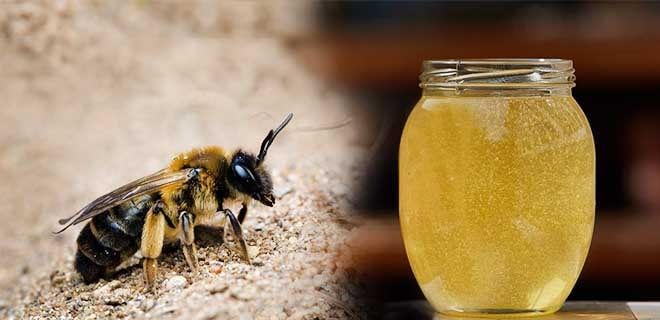

Recommendations for the extraction of nectar:
- the optimal time is autumn, when honey is fully ripe;
- dress in closed clothes, it is advisable to cover your face with a special mesh;
- process bee passages with smoke, dig tunnels to find honey;
- take part of the nectar, but leave most of it to insects so that individuals do not die of hunger in winter.
Earth bees are a large family, the peculiarity of which lies in the lifestyle of the representatives. Individuals equip houses in the soil, for which they dig deep tunnels. They also lay eggs there, store nectar. Another feature is the preference for living alone rather than with families.
Characteristics of earth bees
Earth bees are irreplaceable "helpers" in pollination of fields, gardens, flower beds. They do not pose a threat to humans. They can show aggression, protecting their nest from destruction. They are very hardy and efficient.
Appearance
Individuals of this species differ in color, in which dark shades prevail: black, brown, gray and purple. The outer shell of the insect's body is with a thick bristly cover for survival in cold burrows. The eyes are of a faceted structure, a pair of antennae, two pairs of wings, three pairs of legs, a head with a long proboscis for collecting nectar and an abdomen.


Where dwell
The population of bees is distributed throughout the world. They live, most often, in the wild: in forests, meadows, sheer cliffs with sandy soil and near water bodies.In connection with the active deforestation and the expansion of fields for crops, they are also found in rural areas, in gardens.
Lifestyle
A single species of bees builds small nests, only a few dozen cells. Public and semi-public species settle in colonies - several families can live in one burrow. The offspring builds their dwellings near the parental nest.
It is interesting to read about the characteristics of the Himalayan bees and their honey.
Burrow structure
Burrowing takes a lot of effort, time and is an important factor in family survival. The depth of the tunnels dug by bees reaches 80 cm, with numerous branches and dead-end closets, where nectar is stored and matured, larvae are deposited and reared. First, insects dig an oval tunnel: loose earth is mixed with saliva, this mixture is laid in a circle, tamped and covered with abdominal secretions.
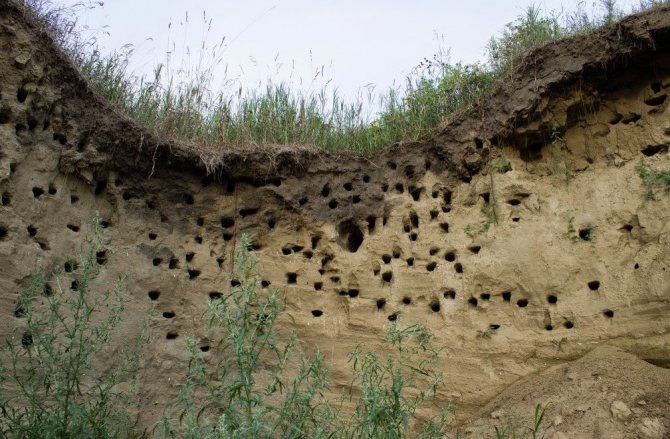

Reproduction
Reproduction takes place as follows. The uterus lays eggs. From fertilized ones, new individuals appear, and from non-fertilized ones - drones. Before becoming a full-fledged bee, the egg goes through several stages of formation: first, it turns into a larva, then into a pupa, and then into an adult. The larvae feed on nectar and pollen.
We also advise you to read how to deal with earth wasps.
Do I need to fight them
If a swarm has settled on a garden plot, then over time the colony will increase in size, which can make the backyard area unsuitable for cultivation, become a dangerous "neighbor". Some species of the described insects lead a parasitic lifestyle - they can steal products necessary for life from domesticated bees.
Important! Before you start fighting the "uninvited guests", you need to prepare protective clothing and equipment: a jacket, overalls, a beekeeper's hat, leather gloves and a smoker. Have antihistamines available.

